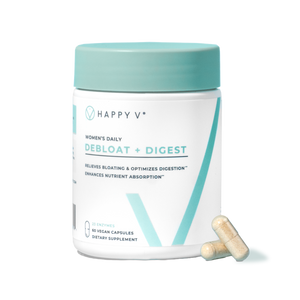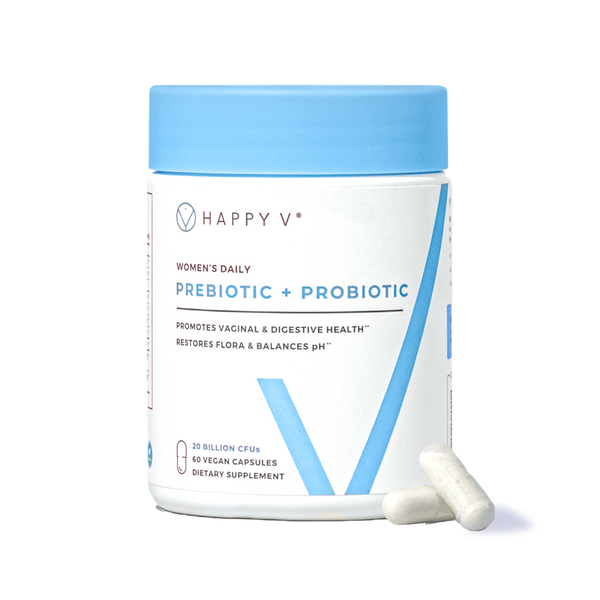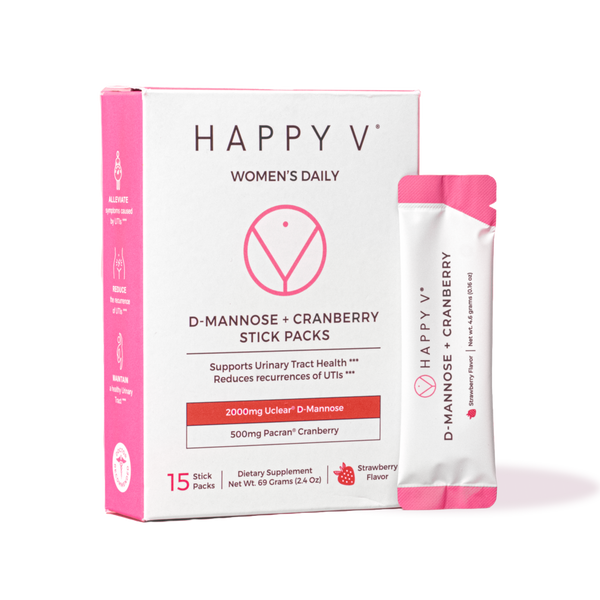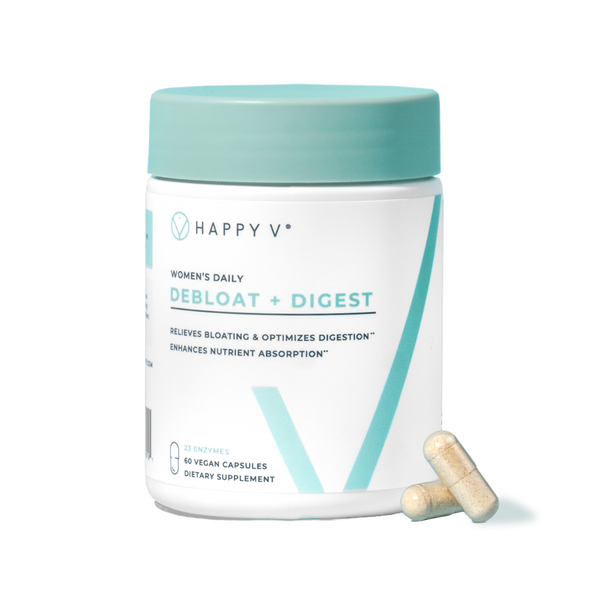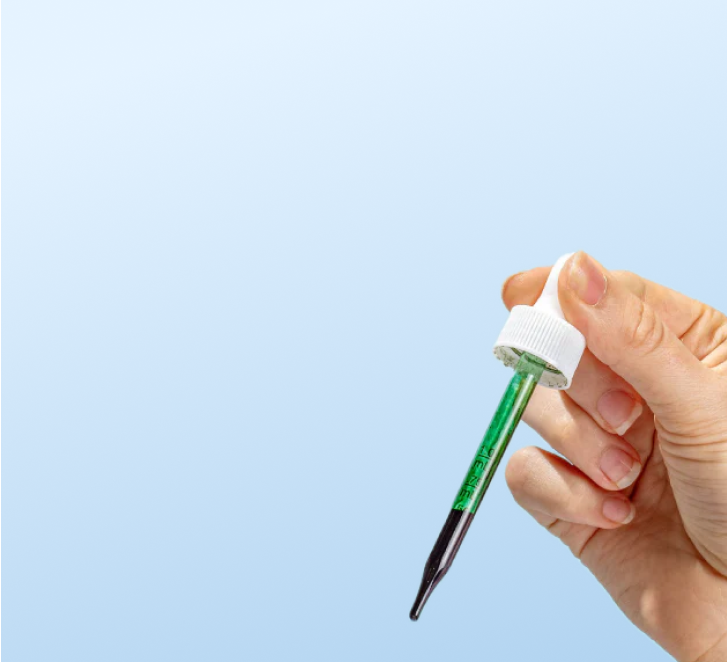- Fact Checked
- October 28, 2025
- 10 min read
Does Amoxicillin Treat BV? What You Need to Know
Table of Contents
Table of Contents
Bacterial vaginosis has a way of showing up at the worst times. It’s frustrating, uncomfortable, and can leave you wondering if there’s a quick fix hiding in your medicine cabinet. Maybe you’ve even eyed that leftover bottle of amoxicillin from a previous ear or sinus infection, hoping it could save you a trip to the doctor. Before you go down that road, let’s talk about what actually works (and what definitely doesn’t) when it comes to treating BV.
This post is for informational purposes only and does not constitute medical advice. See full disclaimer below.
What Is Amoxicillin?
Amoxicillin is a penicillin-type antibiotic that’s been around since the 1970s. It works by blocking bacteria from building strong cell walls1, which they need to survive. Imagine a house being built without bricks or mortar. Eventually, it collapses. That’s essentially what happens to bacteria when amoxicillin steps in.
What Amoxicillin Is Commonly Used For
Doctors typically prescribe amoxicillin to treat various bacterial infections, including:
- Ear infections2
- Sinus infections3
- Pneumonia
- Bronchitis
- Urinary tract infections
- Skin infections
- Strep throat
Side Effects of Amoxicillin
Like all antibiotics, amoxicillin can cause side effects, including:
- Nausea and vomiting4
- Diarrhea5
- Stomach pain
- Headache
- Dizziness
- Skin rash
- Yeast infections (ironically, a common problem after antibiotic treatment)6
Does Amoxicillin Effectively Treat BV?
The short answer: No, amoxicillin is not effective for the treatment of bacterial vaginosis7.
Here’s why: BV is caused by an overgrowth of anaerobic bacteria, like Gardnerella vaginalis and Prevotella, that thrive in low-oxygen environments. Amoxicillin, on the other hand, works best against aerobic bacteria like Streptococcus or Staphylococcus that cause things like strep throat, ear infections, or skin infections8.
Because it doesn’t target the bacteria driving BV, amoxicillin won’t fix the problem. More than that, it can kill off the protective Lactobacilli in your vagina, disrupting your vaginal microbiome further and increasing the risk of recurrent BV or even a secondary infection like a yeast infection or urinary tract infection (UTI).
Does Amoxicillin Benefit Vaginal Health At All?
Generally speaking, no. Amoxicillin doesn’t provide targeted benefits for women’s health or vaginal health. Antibiotics in general are designed to fight off harmful bacteria causing active infections, not to strengthen or support your microbiome. In fact, broad-spectrum antibiotics often do the opposite.
Instead of “choosing” between good and bad bacteria, antibiotics wipe out a wide range of microbes at once. That means they can:
- Kill off protective Lactobacillus bacteria that normally maintain vaginal pH and keep harmful bacteria in check
- Leave room for opportunistic pathogens, like yeast (Candida) or anaerobic bacteria linked to BV, to overgrow
- Trigger secondary infections, like yeast infections, once treatment ends
- Disrupt the vaginal ecosystem in ways that can take weeks (or longer) to rebalance
This isn’t to say you shouldn’t take antibiotics. They are often necessary to fight off an infection, resolve symptoms, and prevent further complications. But it’s important to understand that during and after antibiotic treatment, your vaginal microbiome needs support. That’s where protective measures like vaginal probiotics come in9. (Don’t worry, we’ll dig into that in just a bit.)
What Antibiotics Are Best for BV?
When it comes to fighting BV-causing bacteria specifically, the FDA-approved, gold standard treatment are:
Metronidazole (Flagyl)
- Available as oral metronidazole tablets or vaginal gel
- Specifically targets anaerobic bacteria that cause vaginitis
- Highly effective against BV-causing organisms10
- Usually prescribed for 5-7 days
- Can be used in pregnant women when medically necessary11
Clindamycin
- Available as oral capsules, vaginal cream, or intravaginal suppositories12
- Also effective against anaerobic bacteria
- Often used when metronidazole isn't suitable13
- Clindamycin cream is applied intravaginally14
- Treatment duration varies by formulation
Tinidazole
- Oral antibiotic similar to metronidazole15
- Sometimes used as alternative antibiotic treatment
- May have fewer gastrointestinal side effects
- Effective for recurrent bacterial vaginosis16
Your healthcare provider will choose the best treatment options based on your medical history, previous treatments, and symptoms of BV. They will also take into consideration whether you are pregnant or breastfeeding, since recommendations for these groups may differ from the general population.
Is It Ever Safe to Reuse Antibiotics from Another Prescription?
Absolutely not. N-O. That’s a very not-good idea for a variety of reasons, including:
- Wrong medication for the condition: As we've established, not all antibiotics treat all infections. Using amoxicillin for bacterial vaginosis is ineffective and potentially harmful.
- Incomplete treatment: Leftover antibiotics usually mean you didn't complete a full course, which can contribute to antibiotic resistance.
- Expired medication: Old antibiotics may have reduced potency or could even be dangerous.
- Dosing issues: Different conditions require different doses and treatment durations.
- Masking serious conditions: Self-treating can delay proper diagnosis of more serious health issues like sexually transmitted infections (STIs) or chlamydia.
Moreover, if you’ve ever been prescribed an antibiotic for a previous infection, be it BV, bronchitis, or something else, you should not have any leftovers.
You should always take the full course of antibiotics exactly as prescribed, even if symptoms have resolved. This will help clear the infection completely and prevent it from coming back or, worse, becoming antibiotic-resistant.
How to Seek Proper BV Treatment: Your Options
In-Person Medical Appointments
This is the most common way that people get started with proper BV treatment: they give their office a call and show up to an appointment. If you are experiencing BV symptoms for the first time or a severe infection, it’s also the best route.
Here’s what typically happens:
During Your Visit:
- Medical history discussion - Your provider will ask about your symptoms, sexual activity, recent antibiotic use, and previous vaginal infections
- Physical examination - This includes a pelvic exam to check for signs of inflammation, abnormal vaginal discharge, or other abnormalities
- Sample collection - Your doctor may take a swab of vaginal discharge to test the vaginal pH level and examine under a microscope
- Additional tests - Sometimes they'll order cultures or tests to rule out other conditions like yeast infections, sexually transmitted infections, or other forms of vaginitis
What to Bring:
- List of current medications and supplements
- Menstrual cycle information
- Questions about prevention and treatment options
- Information about your sex partner or sexual partners
- Insurance information and ID
Don't feel embarrassed!
Telemedicine Options: When Virtual Care Works
If you've been diagnosed with bacterial vaginosis before and recognize the symptoms, telemedicine can be a game-changer. Many online platforms now offer specialized women's health services that can:
- Prescribe appropriate antibiotics based on your symptom description and medical history
- Provide follow-up care to ensure treatment is working
- Offer preventive counseling for recurrent cases
- Connect you with specialists if needed
Benefits of Telemedicine for BV:
- Convenience - No need to take time off work or arrange childcare
- Privacy - Discuss sensitive topics from the comfort of your home
- Quick access - Often same-day or next-day appointments available
- Cost-effective - Usually less expensive than in-person visits
- Specialized care - Access to providers who focus specifically on women's health
When Telemedicine Works Best:
- You've had bacterial vaginosis before and recognize the symptoms
- You're dealing with recurrent bacterial vaginosis episodes
- Your symptoms are mild to moderate
- You need prescription refills or follow-up care
- You want to discuss prevention strategies with a specialist
When Telemedicine Isn’t the Best Option
- If this is your first time experiencing symptoms (since other infections can mimic BV)
- If you have severe pain, fever, or unusual bleeding
- If you’re pregnant and experiencing symptoms (you’ll need closer in-person monitoring)
- If your symptoms don’t improve after treatment
When to See a Healthcare Provider
Whether it’s in-person or virtually, you should always seek out your healthcare provider if you’re experiencing:
- Unusual vaginal discharge with strong fishy odor
- Burning or itching that doesn't resolve
- Pain during urination or sex
- Symptoms that keep returning despite treatment
- Severe pelvic pain or fever (could indicate a more serious bacterial infection)
- First-time symptoms (important to get proper diagnosis and rule out STIs)
For Recurrent BV: If you're dealing with bacterial vaginosis that keeps coming back (3+ episodes per year), both in-person specialists and telemedicine platforms can help you develop a long-term management plan that goes beyond just treating individual flare-ups.
How to Prevent BV (and Keep Your Vaginal Microbiome Thriving)
When it comes to BV, prevention really is the best medicine. With a few smart habits, you can stack the odds in your favor and give your vaginal microbiome exactly what it needs to stay balanced.
Daily Probiotics: Your Vaginal Health MVP
Think of probiotics as your vagina’s daily defense team. The most effective formulas for vaginal health include Lactobacillus strains like:
- Lactobacillus crispatus17
- Lactobacillus rhamnosus18
- Lactobacillus reuteri
- Lactobacillus gasseri
Happy V’s Prebiotic + Probiotic was designed with these exact strains (at clinically backed doses, too!) to support both vaginal and gut health. Unlike generic probiotics, ours is built to survive stomach acid and actually make it to where it matters most. Many women notice fewer recurring BV episodes after making it part of their routine.
Practice Good Hygiene (Without Overdoing It)
When it comes to hygiene, less is more. A few simple swaps can go a long way in protecting your vaginal balance:
- Always wipe front to back
- Skip douching (your vagina cleans itself!)
- Use mild, unscented soap externally only
- Change out of wet clothes quickly
- Stick with breathable cotton underwear over tight synthetics
Be Smart About Sexual Health
Sexual activity can change your vaginal environment, but you don’t have to swear off sex to reduce your risk of BV. Instead, focus on these healthy habits:
- Pee after sex to flush out bacteria
- Use condoms with new or multiple partners
- Wash sex toys thoroughly between uses
- Have open conversations about STI testing
- Keep in mind that multiple partners can increase BV risk
Mind Your Diet & Lifestyle
What you eat, drink, and how you manage stress all affect your vaginal microbiome. Supporting your body from the inside out can make a big difference:
- Cut back on sugar and refined carbs (bad bacteria love them)
- Stay hydrated
- Manage stress (exercise, meditation, journaling—whatever works for you)
- Get enough sleep to keep your immune system strong
- Use antibiotics only when necessary (and follow up with daily probiotics when you do!)
Menstrual Health Matters
Your cycle naturally shifts your vaginal environment, but being proactive can help reduce imbalances:
- Change tampons/pads every 4–6 hours
- Try menstrual cups or discs—they may be gentler on vaginal pH
- Track symptoms to see if flare-ups align with your cycle
- Remember: menstrual blood temporarily raises vaginal pH, which can sometimes trigger BV
Above all, remember: supporting your vaginal microbiome isn’t about perfection but about consistency. With the right habits (and the right probiotic support), you can lower your risk of BV and feel more in sync with your body.
Final Thoughts
Amoxicillin isn’t the right treatment for BV because it doesn’t target the bacteria behind it and can disrupt your natural balance. The real solutions are antibiotics like metronidazole or clindamycin when prescribed by your provider, paired with prevention strategies that keep your vaginal microbiome strong.
With the right treatment and proactive care, you can finally break the BV cycle and feel more in control of your health.
Keep the Conversation Going
- Visit our blog for more on BV treatment options and women's health tips.
- Join our private Happy V Facebook group to hear from others who've been there.
- Explore supplements designed to support your vaginal health journey.
Disclaimer: This blog is for informational and educational purposes only and is not intended to diagnose, treat, cure, or prevent any disease. Statements about supplements have not been evaluated by the Food and Drug Administration. For more information about vaginal infections, visit the CDC or speak to a licensed healthcare provider.

